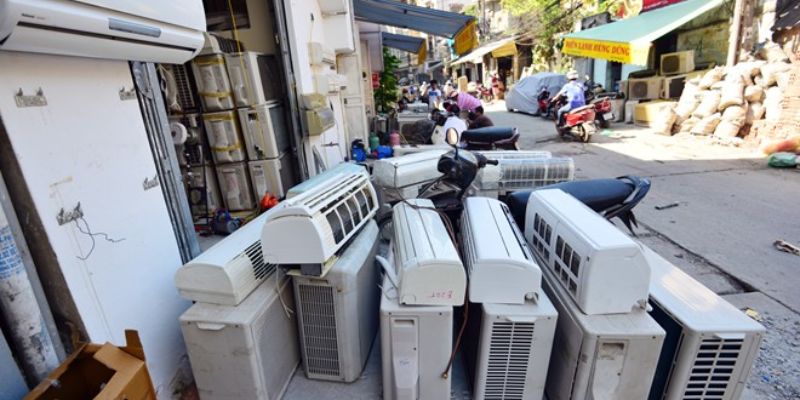Air conditioning systems serve a crucial role in maintaining comfort within homes and businesses, especially in regions with soaring temperatures like Dien Lanh District 7. Whether you are considering disassembling an old unit for repair or replacement or installing a new air conditioner, there are essential notes to keep in mind to ensure everything runs smoothly. This article aims to provide insights into the intricacies of disassembling and installing air conditioners, emphasizing best practices, potential pitfalls, and practical tips.

See more: điện lạnh quận 7
Understanding the Basics of Air Conditioner Mechanics
When it comes to the disassembly and installation of air conditioning units, understanding their inner workings is paramount. This knowledge not only helps in preventing mishaps but also enhances your ability to troubleshoot issues effectively.
The Anatomy of an Air Conditioner
Every air conditioning unit consists of several key components:
- Compressor: Often considered the heart of the system, the compressor compresses the refrigerant and circulates it through the coils.
- Condenser Coils: These coils release heat from the refrigerant into the outside air. They play a vital role in the cooling process.
- Evaporator Coils: Located inside the home, these coils absorb heat from the indoor air, cooling it down before circulation.
- Expansion Valve: It controls the flow of refrigerant into the evaporator coils, ensuring that the right amount of refrigerant enters the system.
Understanding these components provides insights into how they interact during operation. When disassembling or installing a unit, recognizing each part’s function can prevent missteps and facilitate smoother assembly.
Common Problems During Disassembly
Disassembling an air conditioner can lead to several common issues if not handled carefully:
- Refrigerant Leakage: Opening up the system without proper precautions can lead to refrigerant leaks, which are harmful to the environment and can reduce the unit’s efficiency.
- Damage to Components: Mishandling parts during disassembly can cause damage, necessitating costly repairs or replacements.
- Incorrect Reassembly: Failing to remember the arrangement of electrical wires or components can lead to malfunctioning units after installation.
Developing an awareness of these risks underscores the importance of careful planning and execution during both disassembly and reinstallation.
Preparation and Tools Required
Before embarking on a disassembly or installation project, it’s crucial to gather the necessary tools:
- Basic Hand Tools: Screwdrivers, pliers, wrenches, and more are essential for removal and attachment of components.
- Safety Gear: Gloves and goggles protect against potential hazards such as sharp edges or chemical exposure.
- Manifold Gauge Set: A must-have for those working with refrigerants, this tool helps measure pressure accurately during the process.
Preparation is half the battle won. Ensuring you have everything at your fingertips will streamline the process and minimize interruptions.
The Importance of Safety Protocols

See more: điện lạnh TPHCM
In any home improvement project, safety should always be a top priority. Working with electrical appliances and refrigerants poses unique challenges that require adherence to strict safety protocols.
Personal Protective Equipment (PPE)
Using the right personal protective equipment cannot be overstated.
- Gloves: Protect your hands from sharp edges and potential chemicals. Rubber gloves offer an added layer of safety when handling refrigerants.
- Goggles: Eye protection is vital. Not only do they shield against flying debris, but they also guard against accidental splashes of refrigerant.
- Dust Mask: Disassembling units may create dust and particles that can irritate the respiratory system. Wearing a mask helps mitigate this risk.
By equipping yourself with proper PPE, you reduce the likelihood of injury significantly while enhancing your overall productivity.
Electrical Precautions
Dealing with electrical components can be hazardous.
- Power Off the Unit: Before starting any work, ensure the power is completely turned off. This minimizes the risk of electrical shock.
- Use Insulated Tools: Investing in insulated tools protects against accidental contact with live wires.
- Check Wiring and Connections: Inspect all connections and wiring for wear or fraying. Addressing these issues beforehand can prevent larger problems down the line.
These precautions can save you from dangerous situations, allowing you to focus on the task at hand without unnecessary worry.
Handling Refrigerants Responsibly
Refrigerants can be toxic and are subject to environmental regulations.
- Know the Type of Refrigerant: Different systems use different types of refrigerants, such as R-22 or R-410A. Each type has specific handling guidelines.
- Use Recovery Machines: When removing refrigerants, it’s essential to utilize recovery machines designed to handle these substances properly. This prevents leakage into the atmosphere.
- Follow Local Regulations: Ensure compliance with local laws regarding the disposal of refrigerants. Many areas have strict guidelines to safeguard public health and the environment.
Overall, mastering these aspects of safety ensures that you approach air conditioning disassembly and installation with a mindset grounded in responsibility and care.
Steps for Successful Air Conditioner Disassembly
Once you have established a solid understanding of the mechanics and safety protocols, it’s time to delve into the steps involved in disassembling an air conditioning unit. Each step is crucial to achieving a successful outcome.
Preparing the Work Area
Creating a conducive work environment is your first step toward success.
- Clear Space: Remove any furniture or items that could obstruct your movement. This not only improves safety but also allows for easier access to the air conditioning unit.
- Organize Tools: Arrange your tools in an accessible manner. Consider using a toolbox or a dedicated area on your workbench.
- Ensure Ventilation: Depending on the nature of the work, ample ventilation might be necessary, especially if refrigerants are involved.
Having a well-prepared workspace can greatly enhance your efficiency and effectiveness throughout the disassembly process.
Systematic Disassembly Process
Following a systematic approach to disassembly can mitigate confusion and ensure that all components are properly attended to.
- Disconnect Power Supply: Always start by cutting off the power supply to the unit. This is a non-negotiable step.
- Remove Panels Carefully: Use appropriate tools to take off outer panels. Be cautious about damaging screws or clips; consider labeling them for easier reassembly.
- Take Note of Wiring: If you’re disconnecting electrical components, make sure to photograph or label wiring configurations. This will be invaluable during reinstallation.
By following these structured steps, you minimize the chances of making errors that could complicate the reinstallation process.
Proper Storage of Parts
As you disassemble the unit, it’s crucial to store parts correctly.
- Use Containers: Utilize small containers or bags to keep screws, bolts, and other small components organized. Label them according to their original location.
- Protect Larger Parts: For larger components like the compressor or coils, consider covering them with cloth to prevent scratches.
- Maintain Cleanliness: Keeping your workspace clean reduces the risk of losing important parts and makes it easier to navigate during the reassembly phase.
Proper storage solutions can save time and frustration later on, making your workflow smoother and more efficient.
Essential Considerations for Air Conditioner Installation
After disassembly, the next critical step is the installation of the air conditioning unit. Like disassembly, installation requires attention to detail and adherence to best practices.
Location Selection
Choosing the right location for your air conditioning unit is essential for optimal performance.
- Indoor Placement: For split-system units, select a wall that allows unobstructed airflow. Avoid areas blocked by furniture or walls.
- Outdoor Unit Location: Ensure the outdoor unit is placed on a level surface, away from direct sunlight and precipitation. Adequate clearance around the unit promotes effective airflow.
- Consider Noise Levels: Keep in mind that some units can be noisy. Placing them further away from bedrooms or living areas can enhance comfort.
Taking the time to choose the right placement can significantly improve energy efficiency and extend the lifespan of your unit.
Proper Installation Techniques
Employing correct installation techniques contributes to the longevity and efficiency of your air conditioning system.
- Secure Mounting: Ensure that both indoor and outdoor units are securely mounted to avoid vibrations and excessive noise.
- Correct Ductwork Connection: For ducted systems, ensure that ductwork is free from leaks and correctly connected to optimize airflow.
- Refrigerant Line Setup: When connecting refrigerant lines, ensure that they are properly insulated to prevent energy loss.
Attention to these details during installation can make a significant difference in performance and reliability.
Testing and Commissioning the Unit
Once installation is complete, thorough testing is crucial.
- Check All Connections: Double-check that all electrical and refrigerant connections are secure and leak-free.
- Start the Unit: Turn on the air conditioning system and monitor its operation. Listen for unusual noises and check for proper airflow.
- Evaluate Performance: Assess cooling performance in various rooms and adjust settings if necessary.
Conducting these checks ensures that any issues are identified early on, saving you trouble and potential costs in the long run.
FAQs
What should I do if my air conditioner won’t turn on after installation?
If your air conditioner fails to turn on, double-check that the power supply is connected and functioning. Check the thermostat settings and ensure that the circuit breaker hasn’t tripped. If issues persist, it may be wise to consult a technician for assistance.
How often should I perform maintenance on my air conditioning unit?
Regular maintenance is vital for prolonging the life of your air conditioning unit. Ideally, you should schedule professional servicing at least once a year, along with regular filter changes every three months.
Can I install an air conditioner myself, or should I hire a professional?
While many homeowners can manage basic installations, hiring a professional can ensure that the work is done safely and correctly. Professionals also have the experience to address any unexpected issues that may arise during the process.
What signs indicate that my air conditioner needs repair?
Common signs include inconsistent cooling, strange noises, odd smells, leaking water, or high energy bills. If you notice any of these issues, it’s advisable to seek professional help promptly.
Is it worth investing in a high-efficiency air conditioner?
High-efficiency air conditioners often come with higher upfront costs but can result in significant savings on energy bills over time. Additionally, they contribute to reduced environmental impact, making them a worthwhile investment for many homeowners.
Conclusion
Disassembling and installing air conditioning units in Dien Lanh District 7 requires a combination of technical knowledge, attention to safety, and meticulousness. By understanding the mechanics, prioritizing safety, systematically approaching disassembly, and employing precise installation techniques, you can successfully navigate the entire process. While tackling such projects independently can be rewarding, never hesitate to seek professional assistance for complex tasks or if uncertainty arises. Ultimately, a well-installed air conditioning unit not only enhances comfort but also contributes to energy efficiency and the longevity of your system.
